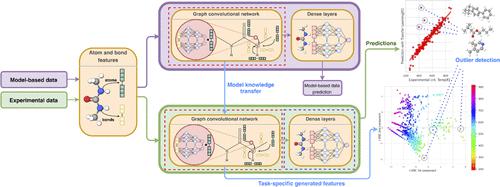当前位置:
X-MOL 学术
›
J. Chem. Inf. Model.
›
论文详情
Our official English website, www.x-mol.net, welcomes your feedback! (Note: you will need to create a separate account there.)
Not from Scratch: Predicting Thermophysical Properties through Model-Based Transfer Learning Using Graph Convolutional Networks
Journal of Chemical Information and Modeling ( IF 5.6 ) Pub Date : 2022-10-31 , DOI: 10.1021/acs.jcim.2c00846 Rodrigo S Hormazabal 1 , Jeong Won Kang 1 , Kiho Park 2 , Dae Ryook Yang 1
Journal of Chemical Information and Modeling ( IF 5.6 ) Pub Date : 2022-10-31 , DOI: 10.1021/acs.jcim.2c00846 Rodrigo S Hormazabal 1 , Jeong Won Kang 1 , Kiho Park 2 , Dae Ryook Yang 1
Affiliation

|
In this study, a framework for the prediction of thermophysical properties based on transfer learning from existing estimation models is explored. The predictive capabilities of conventional group-contribution methods and traditional machine-learning approaches rely heavily on the availability of experimental datasets and their uncertainty. Through the use of a pretraining scheme, which leverages the knowledge established by other estimation methods, improved prediction models for thermophysical properties can be obtained after fine-tuning networks with more accurate experimental data. As our experiments show, for the case of critical properties of compounds, this pipeline not only improves the performance of the models on commonly found organic structures but can also help these models generalize to less explored areas of chemical space, where experimental data is scarce, such as inorganics and heavier organic compounds. Transfer learning from estimation models data also allows for graph-based deep learning models to create more flexible molecular features over a bigger chemical space, which leads to improved predictive capabilities and can give insights into the relationship between molecular structures and thermophysical properties. The generated molecular features can discriminate behavior discrepancy between isomers without the need of additional parameters. Also, this approach shows better robustness to outliers in experimental datasets.
中文翻译:

不是从零开始:使用图卷积网络通过基于模型的迁移学习预测热物理性质
在这项研究中,探索了一种基于现有估计模型的迁移学习来预测热物理性质的框架。传统的群体贡献方法和传统的机器学习方法的预测能力在很大程度上依赖于实验数据集的可用性及其不确定性。通过使用利用其他估计方法建立的知识的预训练方案,在用更准确的实验数据微调网络后,可以获得改进的热物理性质预测模型。正如我们的实验所示,对于化合物的关键特性,该管道不仅可以提高模型在常见有机结构上的性能,还可以帮助这些模型推广到化学空间中探索较少的领域,实验数据稀缺的地方,例如无机物和较重的有机化合物。从估计模型数据中迁移学习还允许基于图的深度学习模型在更大的化学空间上创建更灵活的分子特征,从而提高预测能力,并可以深入了解分子结构和热物理性质之间的关系。生成的分子特征可以区分异构体之间的行为差异,而不需要额外的参数。此外,这种方法对实验数据集中的异常值表现出更好的鲁棒性。这可以提高预测能力,并可以深入了解分子结构和热物理性质之间的关系。生成的分子特征可以区分异构体之间的行为差异,而不需要额外的参数。此外,这种方法对实验数据集中的异常值表现出更好的鲁棒性。这可以提高预测能力,并可以深入了解分子结构和热物理性质之间的关系。生成的分子特征可以区分异构体之间的行为差异,而不需要额外的参数。此外,这种方法对实验数据集中的异常值表现出更好的鲁棒性。
更新日期:2022-10-31
中文翻译:

不是从零开始:使用图卷积网络通过基于模型的迁移学习预测热物理性质
在这项研究中,探索了一种基于现有估计模型的迁移学习来预测热物理性质的框架。传统的群体贡献方法和传统的机器学习方法的预测能力在很大程度上依赖于实验数据集的可用性及其不确定性。通过使用利用其他估计方法建立的知识的预训练方案,在用更准确的实验数据微调网络后,可以获得改进的热物理性质预测模型。正如我们的实验所示,对于化合物的关键特性,该管道不仅可以提高模型在常见有机结构上的性能,还可以帮助这些模型推广到化学空间中探索较少的领域,实验数据稀缺的地方,例如无机物和较重的有机化合物。从估计模型数据中迁移学习还允许基于图的深度学习模型在更大的化学空间上创建更灵活的分子特征,从而提高预测能力,并可以深入了解分子结构和热物理性质之间的关系。生成的分子特征可以区分异构体之间的行为差异,而不需要额外的参数。此外,这种方法对实验数据集中的异常值表现出更好的鲁棒性。这可以提高预测能力,并可以深入了解分子结构和热物理性质之间的关系。生成的分子特征可以区分异构体之间的行为差异,而不需要额外的参数。此外,这种方法对实验数据集中的异常值表现出更好的鲁棒性。这可以提高预测能力,并可以深入了解分子结构和热物理性质之间的关系。生成的分子特征可以区分异构体之间的行为差异,而不需要额外的参数。此外,这种方法对实验数据集中的异常值表现出更好的鲁棒性。


























 京公网安备 11010802027423号
京公网安备 11010802027423号